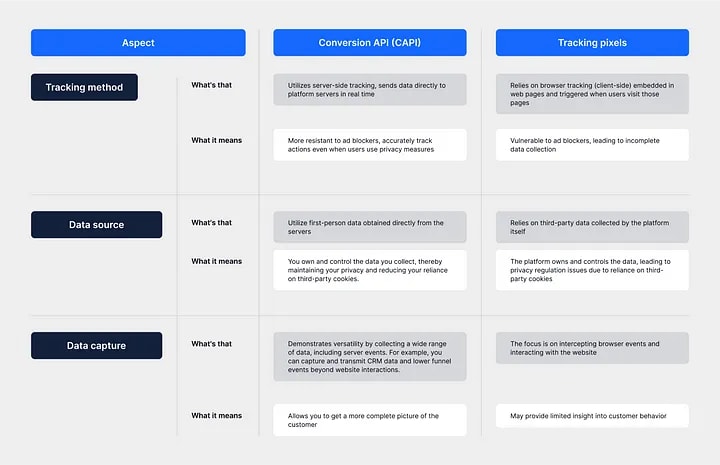Conversion API: Enhanced Tracking and Marketing Strategy Optimization
Conversion API: Enhanced Analytics & Marketing Optimization

After the rejection of third-party cookie files, marketers are seeking ways to enhance user action tracking and optimize marketing campaigns. If you’re involved in online advertising, the term “Conversion API” (or CAPI) has probably caught your attention.
This concept is frequently encountered in advertising strategies and holds immense significance for marketers. Professionals want to keep up with the times, especially considering the changing landscape where privacy is regulated more strictly, and third-party cookies are gradually being phased out.
In this article, we will explore what Conversion API (CAPI) is, developed to address current challenges. With this tool, marketers will be able to track data, optimize strategies, and multiply revenue even as privacy takes center stage.
What is conversion API and how does it impact tracking and optimization
In advertising, the term “conversions” refers to a wide range of actions on a website or in an application, extending beyond simple purchases. They are indicators of user engagement and interest, ultimately reflecting the success of marketing campaigns. Conversions can include product views, completed purchases, content downloads, email subscriptions, form completions, and much more.
The emergence of Conversion API is a response by Meta* and Google to the challenges posed by strengthening privacy regulations and the phasing out of third-party cookies. Such APIs are an important solution to supplement the data that marketers will no longer be able to collect.
For brands, Conversion API is also important because it changes the logic of tracking desired actions. These APIs facilitate the seamless transfer of critical user action data to the Ads Manager of the respective advertising platform. It’s akin to providing real-time updates, enabling marketers to access comprehensive and timely information, thereby enhancing the tracking and optimization of advertising campaigns.
Traditional methods heavily rely on browser tracking and third-party cookies, whereas Conversion API operates on the server side. These changes are key to improving effectiveness.
Conversion API and pixels: what’s the difference
Perhaps the concept of Conversion API reminds you of its counterpart — pixels. Their function is to capture user event data using third-party cookies and transmit it to platforms. This allows marketers to tailor advertising campaigns based on user behavior, ensuring that messages are delivered to those who have shown interest or taken specific actions on online platforms. Pixels play a key role in optimizing advertising performance and are crucial for its personalization and effectiveness.
However, with the phasing out of third-party cookies and the increasing popularity of ad blockers, such tracking using pixels is losing its effectiveness. In response to this, companies are monitoring events through servers and using Conversion API as a powerful alternative.
Comparison of conversion API (CAPI) and pixels:

If you’re facing the dilemma of implementing Conversion API and pixels or just Conversion API, the answer is this: major companies recommend using both options to enhance performance, as pixels are still capable of gathering valuable data. The more information you have at your disposal, the more effectively you’ll be able to tailor your advertising campaigns.
Using conversion API: benefits
Now let’s explain why Conversion API will definitely be useful for you in implementing your marketing strategy:
1. Increased accuracy and reliability of data
Conversion API provides high-precision data and reduces discrepancies caused by ad blockers and browser settings.
Marketers can rely on the data obtained to efficiently optimize advertising campaigns. For example, when tracking conversions, you can be sure that each conversion is accurately recorded. Knowing this information, you can control advertising expenses and increase ROAS.
2. Improvement of attribution modeling
With Conversion API, the selected attribution model becomes more accurate, as you can see the entire customer journey and all their activity through the sales funnel.
Marketers analyze conversions across multiple touchpoints, based not only on web data but also on CRM data, offline conversions, and events at the bottom of the funnel. This comprehensive approach provides an understanding of how different channels influence conversions. This contributes to effective budget allocation.
3. Improved tracking across all devices
Conversion API shows marketers how users behave on a website or other resource from different devices.
This allows specialists to track the customer’s cross-device experience, thoroughly analyzing their interaction with the product. As a result, they recognize the person who responded to the advertisement from a mobile phone and then made a purchase from a computer as the same user.
4. Enhanced privacy
Conversion API helps marketers comply with privacy rules while minimizing dependence on third-party cookie files.
Marketers respect user privacy, thereby building trust. With Conversion API, they collect and transmit data in accordance with privacy requirements, ultimately contributing to building a positive brand image.
5. Minimization of data loss
Server-side tracking using Conversion API minimizes data loss, especially when ad blockers or anonymizers are used.
Marketers know they are recording all data acquisition points. This facilitates comprehensive data analysis and more accurate decision-making.
6. Strengthening data control
Conversion API represents an advanced level of control over the data exchange process because the authority to manage information lies with the advertiser.
Marketers control how data is disseminated within the company. It is specialists who decide which information to transmit and when to do so. They are responsible for securely processing information in accordance with the goals of the company.
Utilize conversion API to track and optimize data without cookie files
So, Conversion API is an important tool in the modern marketer’s arsenal. Its ability to provide data accuracy, improve privacy compliance, and offer comprehensive insights into customer behavior makes it an indispensable asset in the post-cookie era.
With Conversion API, marketers successfully navigate the changes in the world of online advertising and achieve success in an environment where accuracy, trust, and efficiency become priorities. Master Conversion API to stay “in the know” in the constantly evolving digital world and witness how this tool transforms the ways of audience interaction, campaign optimization, and performance enhancement.
* Organization recognized as extremist in the territory of the Russian Federation
Source: Actioniq
The article was originally published here.
About the Creator
Altcraft
Interesting and useful articles about marketing, our product and online communications
Enjoyed the story? Support the Creator.
Subscribe for free to receive all their stories in your feed. You could also pledge your support or give them a one-off tip, letting them know you appreciate their work.






Comments
There are no comments for this story
Be the first to respond and start the conversation.